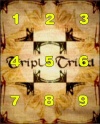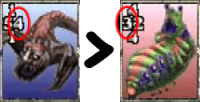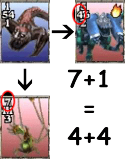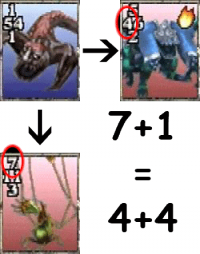Triple Triad
The most popular card game from Deling has started spilling to the multiverse! Play against friends, accumulate points, buy new cards, collect them all! Here you can find all of the information and rules you need to partake into the game as well!
Contents
The Cards
The Back
First and foremost, what is a Triple Triad card ?
There are a few distinguishable features to a Triple Triad card.
First the back of it has an elaborate design, so it's easily recognizable from other playing cards out there. You wouldn't want to be the silly one to pull out a 3 of Diamond in the middle of a game, wouldn't you?
The Front
The other side has a foremost a picture of the person, monster or object that the card is named for. The other noticeable feature are the numbers in the upper right corner, although the numbers might be elsewhere as well, depending on the design. But no matter where the numbers are placed, they are important as to how the 4 numbers are placed.
The direction the number is placed is the 'attack' rating of the card. For Geezard, the 'Up' and 'Down' rating are 1, while the 'Left' rating is 5, and the 'Right' is 4. That direction comes into play during a game. The direction it faces becomes the direction it 'attacks' toward. The ratings are from 1 to A, A = 10 for the purpose of certain rules calculations.
The last feature isn't seen on Geezard, but there are 8 different icons that might appear on the card, giving the card an elemental attribute.
The Gameplay
The board is composed of 9 different areas where the cards can be placed into. Each player starts with 5 cards, and place card one after the other. The cards played 'attack' each other through the ratings seen on the card.
For example, if you place Geezard into the position number 1, the 'Down' rating (1) will attack any card in position 4, and the 'Right' rating (4) will attack the card in position 2.
If there is a card in the positions next to the card, they will be defending using their own opposing ratings. That is, the 'Down' from Geezard would be opposed to the 'Up' for position 4, and the 'Right' of Geezard would be opposed to the 'Left' of the card in position 2.
The way it 'attacks' depends on the rules in play, as there are various rules that dictate the gameplay. When you win over a card through any of those rules, the card gets 'flipped', which is the term used when changing a card from the opponent's color to yours. The two players are Blue and Red, and the one that has the most cards of their own color at the end, including cards left unplayed, win the game.
In case of a tie, the cards are returned to the hands and a new round starts.
There are several rules that determine how a game is played out. There are 2 categories of rules that can be chosen before the game starts, which are GamePlay rules and Trading rules. Once the player agree on the rules, the game starts.
Gameplay rules affect how the game is played out directly, while trading rules apply at the end of the game, on how many cards the victor can pick from the losing's hand.
Gameplay Rules
The Standard Rule
This rule is always in effect, you cannot select it or turn it off, it's the most basic part of the gameplay.
When you play a card, if your rating is greater than the opposing card's rating, you win. If your rating is lower or equal, nothing happens. The thing to remember is that you cannot lose cards during your turn, only turn some to your color. So you can play defensively.
In this example, Geezar's 'Right' rating of 4 beats Funguar's 'Left' rating of 3.
The Same Rule
This rule is a little more complex, as it requires not one, but two opposing cards. Slightly different as well, you don't need that both cards be under your opponent's control, but you need at least one, of course.
This rule plays off that you have matching numbers in two different directions. In this example, Geezard has matching 4s with SAM08G (Geezard's Right 4 = SAM08G's Left 4), and matching 1s with Bite Bug (Geezard's Down 1 = Bite Bug's Up 1).
The key here is that there's two matches, with a single card played. If in this situation Geezard was played here, both SAM08G and Bite Bug would be flipped to Blue.
As said before, if there was only one Red card, it would still trigger the Same rule. It requires at least one opponent card, so you can setup your own cards into a Same combination if you play accordingly. It can be triggered on 3 or 4 cards as well, depending on the position played in.
The Wall Rule
This is an extension of the Same rule, in fact you cannot play with the Wall rule without the Same Rule.
The major difference is that it can be technically triggered with only one opposing card instead of two. In the Wall rule, the 'outside' of the fields is lined with cards with all 'A' values.
In this example, if the Red card was played, the '4' would match with Geezard's Right value. If the 'A' value of the Red card is facing the outward of the field (in position 2 or 3 of the grid in this example), then a Same would be triggered. 'A' rating versus the 'A' of the invisible card outside of the board, and the matching 4s with Geezard.
The Plus Rule
This rule is similar to the Same rule in the way that it requires two opposing cards (Wall does not work here), and that at least one of those cards is controlled by your opponent's.
The major difference is that this rule doesn't require matching ratings, in fact your ratings might be even lower than the opposing cards, unlike the standard rule.
What the Plus rule looks for is matching sums of ratings. In the example here, you can see that the two sums of opposing rating both are '8', which triggers the Plus rule.
Again you need at least one opposing card to trigger this. But its possible to trigger it on several cards depending on the position played in.
The Combo Rule
This rule is the most dangerous of them all. You ever played a game that you see the entire board flipped to your opponent's control with a single card? That's the power of Combo.
This rule requires that Same, Wall or Plus to be triggered first, Combo doesn't trigger on the standard rule.
When Same, Wall or Plus is triggered, every card that were your opponents and now are flipped to your color, are replayed into the game as if they had been set by the standard rule.
To illustrate this, you can look at the animation. Two standard rules, followed by the Plus, finally triggering Combo. What you need to watch in this case is how the Bite Bug gets turned to Blue at the end. That is because of the Standard rule being applied, where SAM08G's Down rating of 2 is higher than Bite Bug's Up rating of 1.
Combo only works on the standard rule, thus it will not re-trigger the Same, Wall and Plus rules again. And only the cards that are flipped are affected. As in the animated example, if one card is already to your color (Blue), it won't propagate Combo.
The last thing to note is that any card flipped by Combo (in this example Bite Bug), also propagates Combo to nearby cards. So Bite Bug will also try to win nearby cards in the same manner.
The Elemental Rule
When playing with this rule, the board might have elemental icons on them. These are randomly placed at the beginning of a game. As noted before, some cards have elemental icons (such as Fire for SAMN08G).
If a card with the same elemental is placed on that position on the grid, then all of the ratings on the card receive a bonus of +1. Thus, Geezard's ratings would become 2 6 5 2 instead. Note at the maximum value of a rating is still 'A', it cannot go any higher.
Inversely, if you put any card that the elemental doesn't match, even if the card has no elemental icon, then that card will receive -1 to all ratings. Geezard's ratings would become 1 4 3 1 instead. Again, ratings cannot get any lower than 1.
Note that elemental value only affects the Standard and Combo rules. Same, Wall and Plus a triggered from the original ratings of the card, and not the elemental modified ratings.
The Open Rule
This rule doesn't affect gameplay directly, but it lets you see what hand your opponent have, what cards he has not played yet. Of course, your opponent gets the same advantage here.
Trading Rules
Trading rules are necessary to the game. If no trading rule is given, the default of One is used.
| Rule | Description |
|---|---|
| None | No cards will be earned by either side. |
| One | One card can be picked from the opponent's hand. |
| All | All cards from the opponent's hand will be taken. |
| Diff | The difference in the score becomes the amount of cards earned. The difference is (Win - Loser) / 2. |









